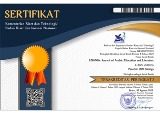Increasing Arabic Vocabulary Mastery Through Gamification; is Kahoot! Effective?
Abstract
Keywords
Full Text:
PDFReferences
Abedalla, R. W. (2015). The Use of Mobile Assisted Languange Learning Applications in Learning Arabic. Issues in Information Systems, 16(2).
Aladdin, A. (2012). Analisis penggunaan strategi komunikasi dalam komunikasi lisan Bahasa Arab. Gema Online Journal of Language Studies, 12, 645–666.
Aladdin, A. (2013). Demotivating factors in the Arabic language clasroom: What demotivates non-Muslim Malaysian learners when it comes to learning Arabic? In H. F. Odabasi (Ed.), Procedia—Social and Behavioral Sciences. 93 (pp. 1652–1657). Elsevier.
Baharudin, H., & Ismail, Z. (2017). Learning Strategies of Arabic Language Vocabulary for Pre-University Students ’ in Malaysia. Asian Social Science, 11(10), 32–38. https://doi.org/10.5539/ass.v11n10p32
Banfield, J., & Wilkerson, B. (2014). Increasing student intrinsic motivation and self-efficacy through gamification pedagogy. Contemporary Issues in Education Research (CIER), 7(4), 291–298.
Barrio, C. M., Muñoz-Organero, M., & Soriano, J. S. (2015). Can gamification improve the benefits of student response systems in learning? An experimental study. IEEE Transactions on Emerging Topics in Computing, 4(3), 429–438.
Barrio, C. M., Muñoz-Organero, M., & Soriano, J. S. (2016). Can gamification improve the benefits of student response systems in learning? An experimental study. IEEE Transactions on Emerging. IEEE Transactions on Emerging Topics in Computing, 4(3), 429–438. https://doi.org/10.1109/TETC.2015.2497459
Buckley, P., & Doyle, E. (2016). Gamification and student motivation, Interactive Learning Environments. Interactive Learning Environment, 24(6), 1162–1175. https://doi.org/10.1080/10494820.2014.964263
Cheong, C., & Filippou, J. (2013). Quick Quiz: A Gamified Approach for Enhancing Learning. Pacis, 206.
Coca, D. M., & Sliško, J. (2013). Software Socrative and smartphones as tools for implementation of basic processes of active physics learning in classroom: An initial feasibility study with prospective teachers. European Journal of Physics Education, 4(2), 17–24.
Dörnyei, Z. (1998). Motivation in Second Language and Foreign Language Learning. Language Teaching, 31(3), 117–135. https://doi.org/DOI: https://doi.org/10.1017/S026144480001315X
Dörnyei, Z. (2001). Teaching and Researching Motivation (First). Pearson Education.
Elam, C., Stratton, T., & Gibson, D. D. (2007). Welcoming a New Generation to College: The Millennial Students. Journal of College Admission, 20–25.
Gao, Y., Yang, M., & Li, L. (2018). Excel and SPSS analysis of independent sample t-test. Animal Husbandry and Feed Science (Inner Mongolia), 39(10), 79–82.
Gerald, B. (2018). A brief review of independent, dependent and one sample t-test. International Journal of Applied Mathematics and Theoretical Physics, 4(2), 50.
Ghenghesh, P. (2010). The Motivation of Learners of Arabic: Does it Decrease with Age? Journal of Language Teaching and Research, 1(3), 235–249.
Graham, K. (2015). TechMatters: Getting into Kahoot!!(s): Exploring a game-based learning system to enhance student learning. LOEX Quarterly, 42(3).
Guilloteaux, M. J., & Dörnyei, Z. (2008). Motivating Language Learners: A Classroom-Oriented Investigation of. TESOL Quarterly, 42(1), 55–77.
Hardré, P. L., & Sullivan, D. W. (2009). Motivating adolescents: High school teachers’ perceptions and classroom practices. Teacher Development, 13(1), 1–16. https://doi.org/10.1080/13664530902858469
Hattie, J., & Timperley, H. (2007). The power of feedback. Review of Educational Research, 77(1), 81–112. https://doi.org/10.3102/003465430298487
Hayyu Desi Setiawati, S. S., & Adi, E. P. (2018). Pengaruh Kahoot!! Terhadap Hasil Belajar Siswa Kelas XI di SMAN 1 Blitar. Jurnal Kajian Teknologi Pendidikan, 1(4), 273–278.
Huizenga, J., Admiraal, W., Akkerman, S., & Dam, G. ten. (2009). Mobile game-based learning in secondary education: Engagement, motivation and learning in a mobile city game. Journal of Computer Assisted Learning, 25(4), 332–344. https://doi.org/10.1111/j.1365-2729.2009.00316.x
Hunt, A., Beglar, D., & Language, R. in a F. (2005). A framework for developing EFL reading vocabulary. Reading in a Foreign Language, 17(1), 23–59.
Islam, A. M. S. (2015). Faktor Demotivasi Pembelajaran Bahasa Arab dalam Perspektif Siswa Madrasah. Arabiyât: Jurnal Pendidikan Bahasa Arab Dan Kebahasaaraban, 2(1), 1–16.
Kapp, K. M. (2012). The gamification of learning and instruction: Game-based methods and strategies for training and education. Pfeiffer.
Keller, J. M. (2009). Motivational design for learning and performance: The ARCS model approach. Springer Science & Business Media.
Khan, I. A., & Al-Shibami, A. H. (2019). Generation Z’s learning preferences: Impact on organisational learning and development-a study conducted in a vocational institute in UAE. International Journal of Learning and Change, 11(4), 379–399.
Matthews, J., Matthews, M., & Alcena, F. (2015). EDD-7914–Curriculum teaching and technology.
McCrindle, M. (2014). The ABC of XYZ: Understanding the Global Generations Kindle Edition. McCrindle Research Pty Ltd.: Sydney NSW, Australia.
Medina, E. G. L., & Hurtado, C. P. R. (2017). Kahoot!! A Digital Tool for Learning Vocabulary in a language classroom. Revista Publicando, 4(12), 441–449.
Melanie, S. (2011). Poll everywhere The Charleston Advisor. The Charleston Advisor, 12(3), 57–60. https://doi.org/10.5260/chara.12.3.57
Mirriahi, N., & Alonzo, D. (2015). Shedding light on students’ technology preferences: Implications for academic development. Journal of University Teaching & Learning Practice, 12(1), 6.
Nurhafizah, N., & Latuconsina, S. N. (2021). Penggunaan Media Flashcard untuk Meningkatkan Penguasaan Mufradat Bahasa Arab Siswa Kelas XI IPA 1 SMA Negeri 1 Mambi Kabupaten Mamasa. Al-Fashahah: Journal of Arabic Education, Linguistics, and Literature, 1(1), 93–98.
Papastergiou, M. (2009). Digital game-based learning in high school computer science education: Impact on educational effectiveness and student motivation. Computers & Education, 52(1), 1–12.
Perrotta, C., & Houghton, E. (2013). Game-based learning: Latest evidence and future directions. NFER.
Plump, C. M., & LaRosa, J. (2017). Using Kahoot!! In the classroom to create engagement and active learning: A game-based technology solution for eLearning novices. Management Teaching Review, 2(2), 151–158. https://doi.org/10.1177/2379298116689783
Prensky, M. (2001). Digital Natives, Digital Immigrants Part 2: Do They Really Think Differently? On The HORIZON, 9(6), 1–9.
Putri, W. N., & Billah, A. (2019). Pengembangan Media Pembelajaran Bahasa Arab Berwawasan Sains Berbasis Mobile Android. LISANIA: Journal of Arabic Education and Literature, 3, 163–179.
Roehl, A., Reddy, S. L., & Shannon, G. J. (2013). The flipped classroom: An opportunity to engage millennial students through active learning. Journal of Family and Consumer Sciences, 105(2), 44–49.
Ryan, A. M., & Patrick, H. (2001). The Classroom Social Environment and Changes in Adolescents’ Motivation and Engagement During Middle School. American Educational Research Journal, 38(2), 437–460. https://doi.org/10.3102/00028312038002437
Saud, I. W., Husain, D., & Helingo, A. (2019). Survei Implementasi Information And Communication Technology (ICT) Dalam Pembelajaran Bahasa Inggris Di SMA Se-Kabupaten Gorontalo. Orbith: Majalah Ilmiah Pengembangan Rekayasa Dan Sosial, 14(3), 176–189.
Siegle, D. (2015). Technology: Learning can be fun and games. Gifted Child Today, 38(3), 192–197. https://doi.org/10.1177/1076217515583744
Syamsiyah, B. (2019). Analisis Kesalahan Berbahasa dalam Imla’ Mahasiswa IAIN Salatiga. LISANIA: Journal of Arabic Education and Literature, 3(1), 21–44. https://doi.org/10.18326/lisania.v3i1.21-44
Thu’aimah, R. A. (1986). Al-marja’ fi ta’lim al-lughah li natiqin bi lughah ukhra. Ummu al-Qurra University.
Thyer, B. A. (2012). Quasi-experimental research designs. Oxford University Press.
Voogt, J. M., Pelgrum, W. J., Owston, R. D., Mcghee, R., Jones, R. M., & Anderson, R. E. (2003). Technology, Innovation, and Educational Change: A Global Perspective: A Report of the Second Information Module 2 (R. B. Kozma, Ed.). International Society for Technology in Education.
Wang, A. I. (2015). The wear out effect of a game-based student response system. Computers & Education, 82, 217–227. https://doi.org/10.1016/j.compedu.2014.11.004
Wang, A. I., & Lieberoth, A. (2016a). The effect of points and audio on concentration, engagement, enjoyment, learning, motivation, and classroom dynamics using Kahoot. 20.
Wang, A. I., & Lieberoth, A. (2016b). The effect of points and audio on concentration, engagement, enjoyment, learning, motivation, and classroom dynamics using Kahoot!!. In Thomas Connolly & L. Boyle (Eds.), The 10th European Conference on Games Based Learning (p. 738). Academic Conferences International Limited.
Wassalwa, A., & Wijaksono, A. (2020). Meningkatkan Kekayaan Mufrodat Siswa Melalui Metode Hypnoteaching. Lahjah Arabiyah: Jurnal Bahasa Arab Dan Pendidikan Bahasa Arab, 1(2), 129–131.
Yien, J.-M., Hung, C.-M., Hwang, G.-J., & Lin, Y.-C. (2011). A Game-Based Learning Approach to Improving Students’ Learning Achievements in a Nutrition Course. Turkish Online Journal of Educational Technology - TOJET, 10(2), 1–10.
Yusoff, M. S. B., Hadie, S. N. H., & Rahim, A. F. A. (2014). Adopting programmatic feedback to enhance the learning of complex skills: A cognitive load-based 1 perspective. Medical Education, 48(2), 104–112. https://doi.org/10.1111/medu.12403
Yusri, G., Rahimi, N. M., Shah, P. M., & Wah, W. H. (2013). Cognitive and Metacognitive Learning Strategies among Arabic Language Students. Journal Interactive Learning Environments, 21(3), 290–300. https://doi.org/10.1080/10494820.2011.555840
DOI: https://doi.org/10.18326/lisania.v5i1.19-35
Refbacks
- There are currently no refbacks.
Copyright (c) 2021 Agus Riwanda, Muhammad Ridha, M. Irfan Islamy
View My Stats







